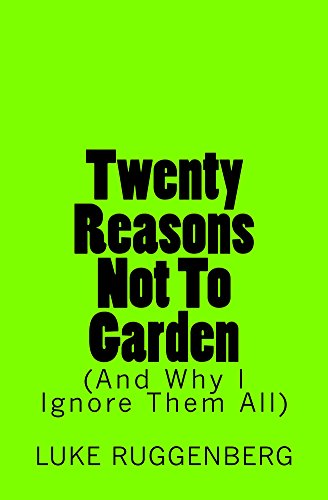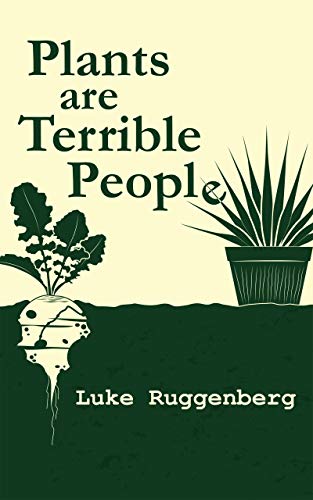Gardening: A Minefield of Confusing Principles
By George Graine, Fairfax Master Gardener
“Democracy is fine in politics. It should stay there, and we need more of it. But its political virtue is no reason to practice it in the garden.”–Allen Lacey
 For the moment let’s move away from the serious interpretations and preachiness about being good stewards of the earth. Also set aside various serious treatises on horticultural plant and design texts, including ones that emphasize sustainability, bio-diversity and ecology. Instead, you are in for a treat if you read these books by Luke Ruggenberg, a prodigious and imaginative creator of two self-published texts. He has a passion for horticulture that is real. His writing is quirky, and you might feel as if you are part of a comedy club routine when reading his books. Actually, beneath the surface of Luke’s stream of consciousness is a plethora of really sound horticultural information and practices. Although you may become mesmerized or giddy if you buy into what Luke has written, his writing, while being funny, at the same time is absolutely instructive.
For the moment let’s move away from the serious interpretations and preachiness about being good stewards of the earth. Also set aside various serious treatises on horticultural plant and design texts, including ones that emphasize sustainability, bio-diversity and ecology. Instead, you are in for a treat if you read these books by Luke Ruggenberg, a prodigious and imaginative creator of two self-published texts. He has a passion for horticulture that is real. His writing is quirky, and you might feel as if you are part of a comedy club routine when reading his books. Actually, beneath the surface of Luke’s stream of consciousness is a plethora of really sound horticultural information and practices. Although you may become mesmerized or giddy if you buy into what Luke has written, his writing, while being funny, at the same time is absolutely instructive.
Luke’s first book “Twenty Reasons Not To Garden (And Why I Ignore Them All),” published in 2017, will surely keep you in stitches. This book recognizes that gardening does not produce a finished product in the usual sense. It is unlike an individual who fashions clay into a bowl. By the time you reach “Self Defense” in Reason #16, Luke notes that plants are really not your friends. More on that in his 2019 book, “Plants Are Terrible People.” Given some serious thought, Luke reminds us that plants have an entire “arsenal” that we must deal with. To be sure, some birds and bees have an affinity for plants, that is, they know their way around plants. On the other hand, we humans need to take heed regarding a variety of nasty problems. To name just a few, consider thorns, sharp leaf margins on ornamental grasses and irritating saps. Oh — and how about getting stabbed by a yucca. Surely you get the point (pardon the pun). If you have difficulty understanding the essence of Reason #16, it capsulizes this in another way. “The garden, even if it’s on your own so-called property, belongs to the plants. It is their territory and you’d do well to concede that.” The “I Can Quit Any Time” is Reason #20. Is this true? Of course not! The truth according to Luke is, “I can’t quit this inglorious, aching, annoyingly satisfying life any more than I could quit myself.” And there it is.
 Now on to the OMG book “Plants Are Terrible People.” In the chapter called “Let’s Euphemize!” (not a typo), Luke insists it is all about being realistic when regarding your gardening efforts or non-efforts, if that is the case. It takes “… time, money and energy to unify dozens of ideas that have splattered all over the lot like a sneeze.” Who would have thought that weeds according to Luke are the sine qua non of the plant world? If you do not agree, then Chapter 1 just might convince you otherwise. Gardeners — rise up and quick like a bunny find your Hori-Hori knife because weeds are on the loose.
Now on to the OMG book “Plants Are Terrible People.” In the chapter called “Let’s Euphemize!” (not a typo), Luke insists it is all about being realistic when regarding your gardening efforts or non-efforts, if that is the case. It takes “… time, money and energy to unify dozens of ideas that have splattered all over the lot like a sneeze.” Who would have thought that weeds according to Luke are the sine qua non of the plant world? If you do not agree, then Chapter 1 just might convince you otherwise. Gardeners — rise up and quick like a bunny find your Hori-Hori knife because weeds are on the loose.
Moving on to NPK, unlike the chemicals instead think New Plants Know. Will they be bigger, better, expensive? After all, many of you are probably considering the “must have” plant du jour. Now hold on jest a minute pardoner (western speak). Will you be sold a bill of goods? Is the new plant a perennial or one of those “temperennials?” Will the variegated whatever go through a reversion back to its true parentage — all green? Ugh! What’s a mother to do? Moving on to vegetables, perhaps you have had a Luke-like experience. The choices are too numerous to contemplate. Think heirlooms, hybrids, new introductions and do not forget the leftover seeds from the previous year. To get more Lukeish, the next problem after planting is to wonder if you made a mistake. Consider this. Will you end up with a reputation similar to the zucchini lady because you planted pak choi, kohlrabi or rutabaga? In other words, have you launched a veggie horror show?
Now we come to a real garden savant. This is the gardener who is forever and ever not satisfied where he planted the whatever. Apparently uprooting is the only solution. Is this some sort of sickness? Beware, is this a “gardenocalyps?” Does this gardener need a cure or just a positive maybe? Will this garden ever be ready for the tour? Perhaps the dog-like command “sit-stay” should be the solution.
Even though there is a world of difference between the “common horticulturist” (probably you the reader) and a “talented creator of gardens” (a.k.a. landscape designer) this is not surprising at all. If your garden is a reflection of you, then should you care what others think? Wipe the word incompetence from your horticultural design and plant experience. You need to trust your own instincts. Do some research, go to a botanic garden and be aware of the basics of sun and soil. Recognize what it takes for good design and account for the amount of time you want and need to spend in the garden. Of course, it will help when you know in advance what to expect from your plants, and they will, in a manner of speaking, talk to you.
As the chapters roll on, you may see yourself differently and decide to make some changes to your horticultural life. Maybe it is true that you need a combination of madness and brilliance. Why? Because this may be necessary to implement whatever it is that you desire to achieve. You are your own judge and jury. Out there is a host of talented specialists each representing a myriad of disciplines. It is up to you to select your own dream team unless you are thinking of a go-it-alone DIY project.
For additional information about Luke Ruggenberg, put www.lukeruggenberg.com in your computer search box. Good luck!